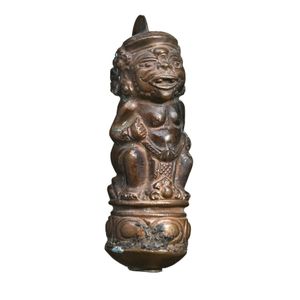Tereszczuk Chryselephantine Figure on Onyx Base, 35 cm Height
You must be a subscriber, and be logged in to view price and dealer details.
Subscribe Now to view actual auction price for this item
When you subscribe, you have the option of setting the currency in which to display prices to $Au, $US, $NZ or Stg.
- Ivory - Ivory is a hard white material that comes from the tusks of elephants, mammoth, walrus and boar, or from the teeth of hippopotamus and whales. The ivory from the African elephant is the most prized source of ivory. Although the mammoth is extinct, tusks are still being unearthed in Russia and offered for sale.
Ivory has been used since the earliest times as a material for sculpture of small items, both in Europe and the east, principally China and Japan.
In Asia ivory has been carved for netsuke, seals, okimono, card cases, fan supports, animals and other figures and even as carved tusks.
In the last 200 years in Europe ivory has been used to carve figures, for elaborate tankards, snuff boxes, cane handles, embroidery and sewing accessories, in jewellery and as inlay on furniture. Its more practical uses include being used for billiard balls, buttons, and a veneers on the top of piano keys.
The use and trade of elephant ivory have become controversial because they have contributed to Due to the decline in elephant populations because of the trade in ivory, the Asian elephant was placed on Appendix One of the Convention on International Trade in Endangered Species (CITES), in 1975, and in January 1990, the African elephant was similarly listed. Under Appendix One, international trade in Asian or African elephant ivory between member countries is forbidden. Unlike trade in elephant tusks, trade in mammoth tusks is legal.
Since the invention of plastics, there have been many attempts to create an artificial ivory - Onyx - Onyx is a form of agate, used from antiquity and popular again in the 1920s and 30s. European onyx is generally green, but can be many other colours, and can contain bands of black and/or white.
This multicoloured stone is widely used for table tops, lamp bases and in jewellery. Some types of onyx are also used for cameos of which the upper white layer is cut away to reveal the colour beneath. - Chryselephantine - Chryselephantine is not a name for a single material or substance. Originally, chryselephantine was the name given to sculptures made from gold and ivory, a technique in use since the second millenium BC.
The word was derived from a combination of the Greek words for "gold" and "ivory".
Due to the high value of some of the materials used and the perishable nature of others, most chryselephantine statues were destroyed during antiquity and the Middle Ages.
However "chryselephantine" is now used to describe a statue, usually from the Art Nouveau period in which the skin is represented by ivory, and the clothing and other items in the statue are made from another material, most commonly bronze.
A more common way to describe a statue made from these materials would simply be as a "bronze and ivory" [figure].
Other materials used included marble, onyx and silver.
This item has been included into following indexes:
Visually similar items

A Chinese seated Buddha, his hands in Abhaya and Varada mudra, seated in Dhyanasana on a double lotus base, 21 cm high

A Chinese gilt-bronze seated figure of a Buddha, possibly Vairochana, and style of Ming dynasty, height 18 cm. Provenance: Private collection, Singapore, acquired in Singapore in the early 1990s

Bali, handle, copper modelled in the form of a Parekan figure, 10.5 cm height

A Dutch sterling silver sugar caster, of swirl reeded baluster shape, the foot ends in gadroon border, flame finial to the top. Hallmarked 1851. Height 20 cm
